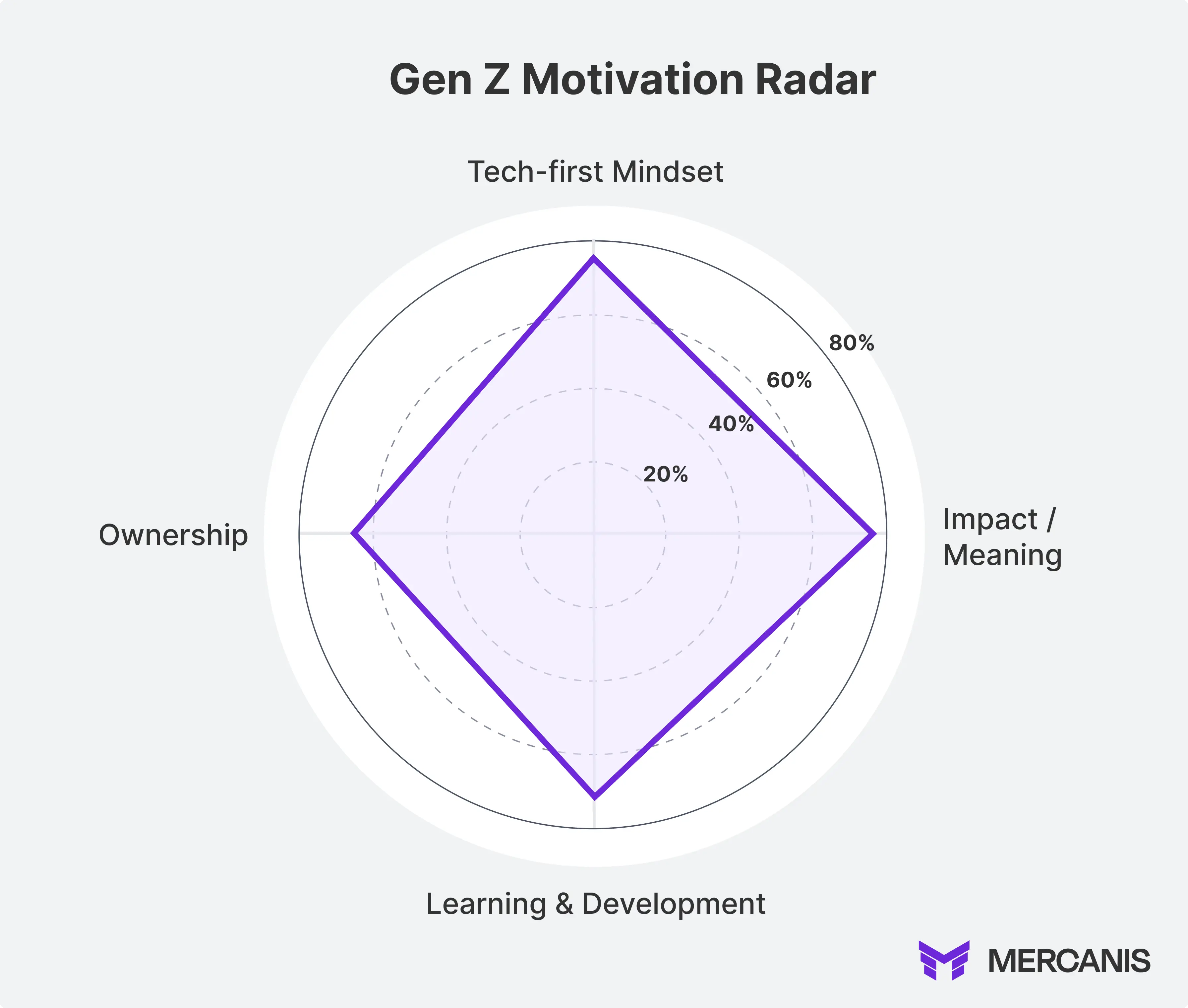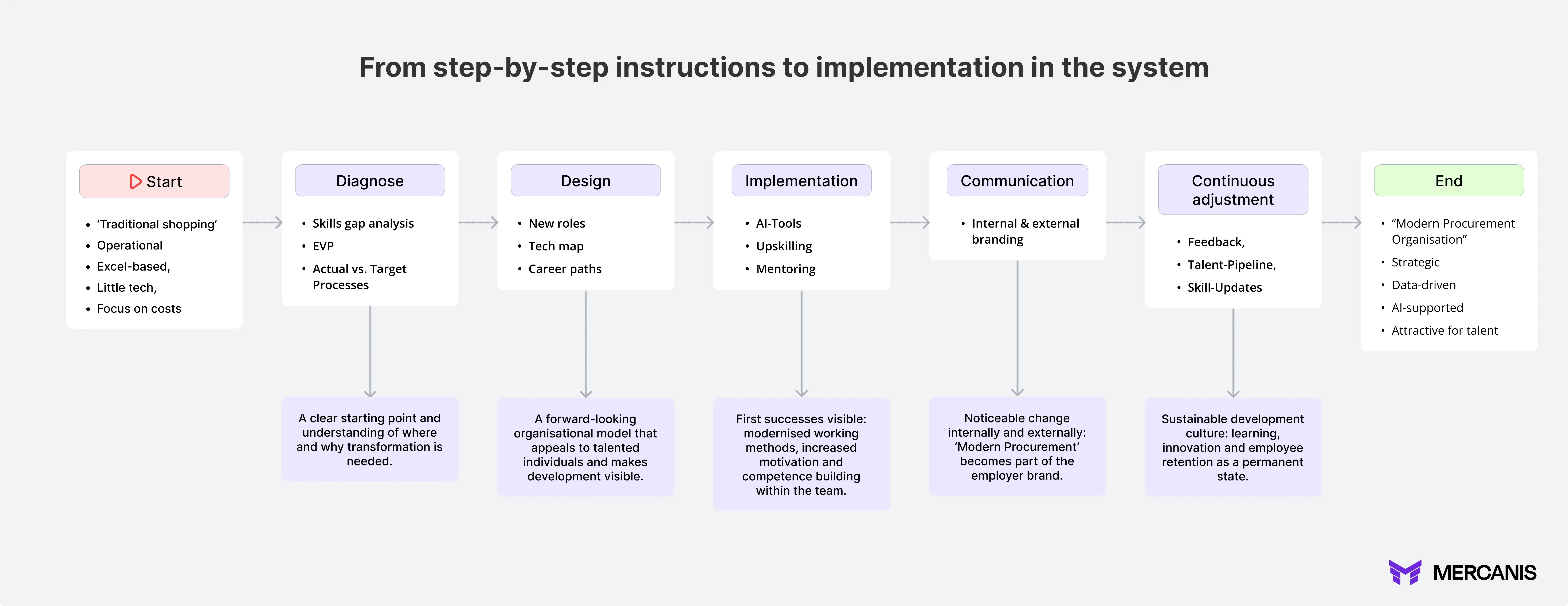
For a long time, procurement was considered a classic cost center, efficient, process-oriented, rule-driven. A department that works in Excel, processes compliance lists, and is primarily responsible for “reducing costs.” But this image will no longer reflect reality in 2025. The demands placed on procurement organizations have changed radically: digitalization, automation, global risks, and new value creation models require different skills, different role profiles, and a completely new self-image. This is also evident in recent studies: the article “Curing all that ails the procurement talent pipeline” makes it clear that the talent gap in procurement has long been a reality and is not just a perceived problem. The Hackett study “Procurement Key Issues 2023” underscores this urgency with a clear diagnosis: 54% of the companies surveyed see “talent shortages” and the “inability to fill critical roles” as a critical risk. In an environment where there is more demand for modern procurement expertise than there are qualified candidates available, the old cost center approach is no longer sufficient – the war for talent is hitting procurement harder than ever.
Procurement is at a strategic turning point today. Not only are markets changing, but so are the skills that modern procurement organizations need. Three forces are driving this development:
Deloitte confirms this pressure emphatically: Digital transformation and advanced analytics are now among the top priorities in procurement. At the same time, there is a lack of suitable talent. This creates a gap between aspiration and reality, forcing companies to realign their talent strategy.
Gen Z is the first working generation to have grown up completely digitally. Their mindset is a match for the requirements of modern procurement – if companies understand these talents and use them correctly. The procurement talent attraction can be difficult from time to time.
What particularly shapes Gen Z:

The CIPS article “Hiring Generation Z for Procurement and Supply” sums up their value to procurement perfectly:
“A new generation of ambitious digital natives ... exactly what it takes to meet procurement's coming challenges.”
This makes it clear: Gen Z is not the problem, they are the solution. The prerequisite is that procurement organizations create an environment in which technology, development, and meaningfulness are a lived reality. Procurement organizations can profit from the mindset of young procurement professionals.
Young people don't want to experience procurement as an “ordering department,” but as what it actually is today: a strategic value driver. They expect roles that have an impact on products, sustainability, and innovation – not just cost pressure and compliance. It's about visibility, participation, and recognition for their impact. Organizations that clearly position procurement as a business partner are significantly more attractive in this regard.
Gen Z has grown up with technology – AI, analytics, and automated platforms are second nature to them. Accordingly, they expect a digital working environment in procurement that enables them to:
The article “What can procurement professionals learn from young professionals” emphasizes that young talents consider a data-driven, modern working environment to be a basic requirement. Those who offer them Excel marathons instead will lose them to tech companies, consulting firms, or start-ups.
Gen Z wants creative freedom – not after three years, but right away.
They want to take on responsibility, solve problems, and contribute their ideas in cross-functional teams. They want to see that their work is having an impact.
In recruiting, this means:
When procurement organizations enable ownership, both the motivation and loyalty of young talent increase significantly.
For Gen Z, continuing education is not a bonus – it is a key selection criterion. They expect clear development paths, mentoring programs, and the opportunity to continuously expand their skills. The CIPS article “The rising young stars of procurement and supply” clearly shows how strongly young professionals are attracted to companies that take training, mentoring, and structured skill building seriously.
What they are specifically looking for:
Companies that actively offer this automatically position themselves as attractive employers – and secure the talent that will shape the procurement of tomorrow.
Despite all the opportunities and technological developments, procurement still blocks itself in many areas. The reality in many organizations looks like this: rigid processes, overloaded compliance structures, Excel overkill, and role profiles that offer little creative freedom. Not only does this seem old-fashioned, it is simply unattractive to young talent.

The Hackett study reveals a telling paradox: although talent management is considered the most important initiative, it does not even appear in the top 10 actual priorities. This means that the need is recognized, but implementation is lacking. This is precisely where the talent gap arises, putting modern procurement organizations under increasing pressure.
There is another stumbling block: the way procurement presents itself in job advertisements. The article “What can procurement professionals learn...” emphasizes that many job ads with long, undifferentiated lists of requirements tend to deter rather than attract candidates. Instead of clear visions, development opportunities, and technological perspectives, bullet points about duties, tools, and internal processes dominate. This creates an image of routine, narrow-mindedness, and little future potential among young applicants – exactly the opposite of what modern talent is looking for.
In short, many procurement organizations want talent, but have not yet created an environment in which modern talent can flourish. And until that changes, even the best recruiting initiatives will fizzle out.
To attract Gen Z, procurement needs to rewrite its own narrative. Instead of process handling, approvals, and price negotiations, it needs a clear role model: strategic value engineering. Procurement becomes the architect of resilience, sustainability, supplier innovation, and competitive advantages. When this story is communicated externally – on career websites, social media, and job profiles – Gen Z suddenly no longer sees an administrative department, but a future-oriented role with impact.
At the heart of the transformation is the redefinition of the work itself. Routine activities must be consistently automated:
This creates space for what really appeals to Gen Z:
It's a role change – away from “process handler” to “business designer.”
Young talents expect modern tools – not just as support, but as a central work logic. AI-driven supplier discovery, autonomous market analysis, decision intelligence agents, predictive monitoring, and integrated data platforms create an environment in which Gen Z can leverage their technological strengths. Studies clearly show that modern procurement tech stacks are one of the biggest factors attracting young talent today. Organizations that invest in this area are sending a clear message: We are building the future, not managing the past.
Technology alone is not enough – Gen Z pays close attention to culture, values, and purpose. This is what determines whether talent stays.
What matters:
The CIPS podcast "The Next Wave: Gen Z in Procurement" clearly confirms this: Young talents are not just looking for jobs, but for meaning, creative freedom, and an environment that is open to ideas. Organizations that actively shape this cultural shift not only attract talent – they also retain it.
(concrete, implementable, and geared toward modern talent needs)
Making a procurement organization attractive is not a matter of chance, but a structured transformation process. These five phases form a practical roadmap that strengthens both recruiting and retention. The article “Curing all that ails the procurement talent pipeline” emphasizes in particular that early investment in talent pipelines is crucial to securing skills in the long term.

Before transformation can begin, an honest picture of the current situation is needed:
This phase is the basis for prioritization and focus – nothing demotivates talent more than unclear goals and vague roles.
Now it's time to shape how procurement should function tomorrow:
This is where the cornerstones of the new working world in procurement are created.
Transformation does not happen on slides – it happens in operational practice.
Important: Promote a culture of error. Performance increases when learning is allowed.
Now the new reality must also be recognized:
If no one sees the change, it doesn't exist. Transparent communication makes procurement magnetic.
Successful procurement organizations remain agile.
The article “Curing all that ails the procurement talent pipeline” emphasizes precisely this point: Talent development must be proactive and long-term – not reactive and delayed.
(based on best practices from the CIPS article “How to attract and retain the best procurement talent”)
An attractive employer profile is crucial today: 94% of applicants check the brand before applying. Visibility, values, culture, and success stories make procurement a real destination.
Don't just post jobs, post insights: team culture, projects, people. Authentic content strengthens loyalty and arouses curiosity – exactly what young talent is looking for.
Application processes must be fast, simple, and appreciative. The focus is on “What can we offer you?” instead of “What do we want from you?” Modern talent expects positive, service-oriented recruiting.
Remote work, flexible working hours, and output-oriented models are a massive attractiveness factor. 75% of respondents want more flexibility – and this is directly reflected in their choice of employer.
Regular appreciation—whether it's a “thank you” or structured rewards—increases motivation and loyalty. A culture of recognition should be actively communicated and celebrated.
No more annual reviews: younger generations demand continuous mentoring, feedback, and development discussions. This strengthens personal responsibility and performance.
Training, upskilling, and development paths are key criteria for Gen Z. Companies that invest in these areas retain talent longer and maintain a strong skills profile in procurement.
Procurement is at a turning point in 2025, and this is an opportunity, not a threat. Young talent is looking for impact, meaning, ownership, and technology. Modern procurement can offer all of this – if organizations are willing to move away from the old cost center mindset.
The data speaks for itself: The Hackett study shows rising expectations for digitalization, automation, and strategic transformation – while staffing levels remain stagnant. The pressure is increasing, but so is the potential.
Those who invest in talent strategy, cultural change, and technology today will not only create more attractive roles, but also build a procurement organization that makes a difference. Tomorrow's procurement will not be a reactive process manager, but a strategic orchestrator, and it is precisely this image that attracts the generation that will shape procurement in the future.
The competition for talent is real – but procurement has everything it needs to win it.
The only question is: Which organizations will seize this opportunity, actively shape their future, and position procurement as a real destination for ambitious young professionals?

This question uses the central keyword “procurement Generation Z” and addresses the main interest of many search queries relating to employer branding, culture, and digitalization.

Focused on “AI in procurement” and “technology in procurement” – two strong SEO topics with high relevance and growing search volume.

This includes the keyword “skills shortage in procurement” – a frequently searched term in the B2B context.

Serves search queries for “employee retention in procuremet” and “retention of young talent.”

Contains the keyword “modern procurement 2025” and arouses curiosity about future trends and organizational transformation.




